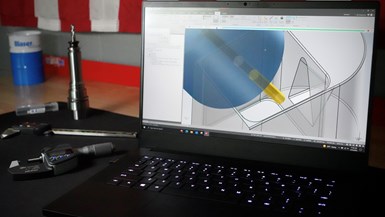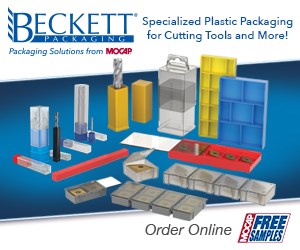How to Tackle Tough Angled Pocket Milling With Two Tools
Milling a deep pocket with a tight corner radius comes with unique challenges, but using both a flat bottom drill and a necked-down finishing tool can help.
Share





Reader Question
I have an application where I am milling a deep pocket in 6061 with a tight corner radius — 3/16 inch — into an angled surface. The maximum depth of the pocket is 1 inch deep (5× deep). The pocket is inside of another pocket, so toolholder clearance is also a problem. What’s more, the cut is very prone to chatter. How can I successfully mill this pocket?
Miller’s Advice
Pockets like this are tricky because of so many competing factors, but identifying the overlying issues and constraints is a good first step to developing a solution. Ideally, you could use a larger tool, but you’re constrained by the pocket radius. Shortening the tool stick could help, but the primary pocket makes this impossible. The angled surface also leads to some interesting limitations as far as tool selection.
Even after you’ve selected the tool, the cut is prone to chatter, so you must determine the magnitude and direction of the cutting forces, as well as the system’s stiffness. Getting the cutting forces up into the spindle can be a huge benefit in this application, just like high feed milling in hard metals. Any cutting forces normal to the tool are the enemy. While you can’t eliminate all normal forces — given the pocket geometry, you must finish-mill the cut — you can reduce them. Anything you can do to add rigidity near the cut will also improve stiffness. Because this is a pocket within a pocket, you’ll also face significant clearance limitations.
With these difficulties in mind, it’s time to dive into the different components, and solve each as best as possible given the constraints.
The first thing you are up against is the tool diameter. Unfortunately, barring any design changes, the 3/16-inch tool at 5× deep is here to stay. Since you can’t change it, work with it. You want to reduce the amount of work you’re asking of this tool as much as possible.
One reduction strategy would be to use separate tools for finishing and roughing. A two-tool strategy will reduce the load on the tiny finisher and provide better tool life. It could even shorten the cycle time compared to a single-tool process — roughing’s increased productivity can counterbalance any time added for tool change and positioning.
Next, address the pocket. Since your challenging pocket is within another pocket, you can’t change much with the tool holder to increase stiffness. Yet you still need as much support as you can get, as close as possible to the cutting point. In this instance, a necked-down end mill (an end mill with a larger shank than cutting diameter) is wise. This will give you more stiffness where the tool holder can’t fit without rubbing against other critical features of the part.
The angled surface is the most unique aspect of this cutting problem. Drilling out difficult pockets is typically a good solution. Drilling provides high removal rates, and the forces go where the machine and tool setup are strongest. In fact, it’s a common strategy in large titanium or hard metal parts. However, the angled surface changes that formula a bit. Fortunately, indexable drills or solid carbide flat-bottom drills are up to the task. These drills also have the benefit of being able to drill overlapping holes! Given how small this pocket is, perhaps a carbide flat-bottom drill is ideal here. It can fit tightly into that 3/16-inch radius and leave minimal material in the area at highest risk for chatter.
Bringing together these solutions, start by switching to a two-tool process. The first tool should be a 4- or 4.5-mm flat bottom drill (just smaller than the finish radius) for roughing the entire pocket, leaving only small scallops and a little floor material left for finishing. The second, necked-down finishing tool will greatly improve the overall stiffness, and when combined with the minimal finishing stock, should enable a more productive finishing operation.
Related Content
GWS Tool Group End Mill Provides Dynamic Milling
Eastec 2023: The Hurrimill AT4 all-terrain end mill features radial-end gashing, which enables drilling, steep ramping and aggressive helical entry.
Read MoreShoulder Milling Cuts Racing Part's Cycle Time By Over 50%
Pairing a shoulder mill with a five-axis machine has cut costs and cycle times for one of TTI Machine’s parts, enabling it to support a niche racing community.
Read MoreCeratizit Product Update Enhances Cutting Tool Solutions
The company has updated its MaxiMill 273-08 face mill, WPC – Change Drill, as well as the HyPower Rough and HyPower Access 4.5-degree hydraulic chucks.
Read MoreNidec Universal Head Enables Versatile Machining
The compact universal head enables better accessibility between the tool and the workpiece, as well as improved surface-finish quality, greater motion range and high-efficiency machining under ideal machining conditions.
Read MoreRead Next
Why We Ask Machine Shop Leaders to Speak at TASC – The Automated Shop Conference
TASC is our industry’s premier peer-to-peer automation stage where America’s shop leaders refine the art of metalworking and CNC machining. For conference speakers, it's also an opportunity to showcase your skills and gain exposure for your business. Here are five why stepping into the spotlight at TASC could be your smartest move toward elevating your shop.
Read MoreRegistration Now Open for the Precision Machining Technology Show (PMTS) 2025
The precision machining industry’s premier event returns to Cleveland, OH, April 1-3.
Read MorePicking the Right End Mill
Kennametal global product manager Katie Myers explains how cutting tool features can impact machining strategies for different materials.
Read More































